Monday, November 14th, 2011
Ancient Greeks and Romans Broke their Pediments
Like other Baroque art historians, I love the broken pediment as an architectural feature. A broken pediment is “broken” at the apex of a triangular pediment. I usually don’t differentiate between the “open” and “broken” pediment when I teach by students about these features, but I know that many architectural historians choose to differentiate between the two. An “open” pediment refers to when the base of the pediment has been removed (or “opened,”). One of my favorite broken pediments from the Baroque period (which actually has been broken, opened, and also shifted backward) is found in the Cornaro Chapel, designed by the artist Bernini (1645-1652).
Both open and broken pediments were popular in Baroque art. Baroque scholars love these kinds of pediments; they serve as good examples of how 17th century architects added a little bit more dynamism and movement into their architectural features (in contrast to the harmony and symmetry that characterized much of the architecture of the Renaissance).1
But I think that it’s hard for Baroque scholars to remember sometimes that the idea of segmenting pediments was not developed during the Baroque period. In fact, the broken and/or open pediment existed in ancient Rome and Hellenistic architecture from Alexandria.2 Unfortunately, not many extant examples of architecture survive from Alexandria, so scholars need to look to Roman and/or Nabatean art that copied Alexandrian architecture, such as the Market Gate of Miletus, Treasury at Petra, and Pompeiian wall paintings (all shown below).
I often teach my students about how the Greek Classical period is similar to the art of the Renaissance, and how the Hellenistic period is similar to the art of the Baroque period. The broken pediment in Hellenistic architecture is a further manifestation of this fact. It’s also interesting to see that the Romans picked up on this architectural feature that would probably have been conceived as “distorted” by Greeks who lived during what has been termed the “High Classical” period. In this light, the broken pediment is another manifestation of how Roman architecture was interested in the re-invention of Classical Greek architecture. No wonder they latched onto the Hellenistic invention of the broken pediment.
Here are some examples of broken pediments that appear in ancient Roman art:
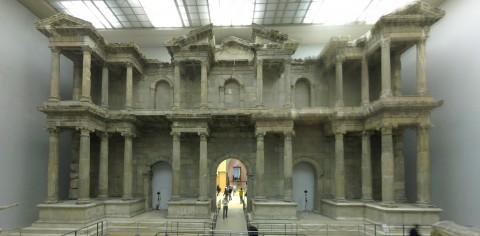
Market Gate of Miletus, 2nd century CE. Currently located in the Pergamon Museum (Berlin). Image courtesy of Thorsten Hartmann via Wikipedia.
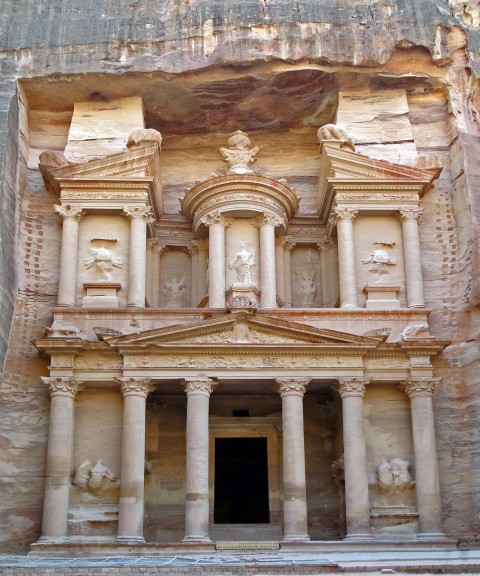
Facade Al-Khazneh (The Treasury), Petra, Jordan, 2nd century BC -2nd century CE. Image courtesy of Bernard Gagnon on Wikipedia.
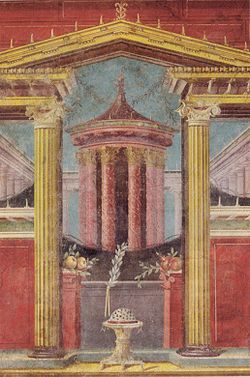
Detail of second style wall paintin from cubiculum M of the Villa of Publius Fannius Synistor, Boscoreale, Italy, ca. 50-40 BCE
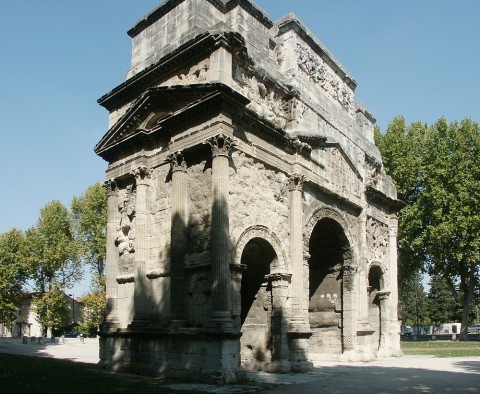
Arch of Tiberius, ca. 26 C.E. (rebuilt around core of earlier monument, ca. 30 B.C.E.), Orange, France
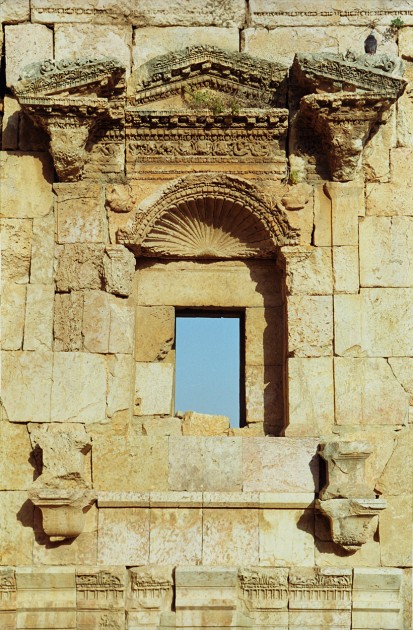
Broken pediment from Temple of Artemis, Jerash, Jordan, c. 150 CE. Image courtesy of Jerzy Strzelecki via Wikipedia.
What are your favorite examples of the broken (or open) pediment in architecture?
1 That being said, there are examples of the broken pediment that exist in Late Renaissance architecture. For example, Antonio da Sangallo the Younger employed broken pediments on the top story of the façade of the Palazzo Farnese (ca. 1530-1546).
2 See Judith McKenzie, “The Architecture of Alexandria and Egypt, 300 BC to AD 700, Volume 63” (New Haven: Yale University Press, 2007), 105. Source available online here. See also Judith McKenzie, “Alexandra and the Origins of Baroque Architecture,” available online here. The latter citation also includes a discussion of how the earliest surviving examples of the segmental pediment (a rounded, semi-circular pediment) are found in Alexandrian architecture.
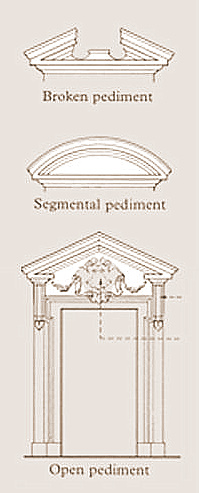
Petra!
Fascinating post M! It’s always good to have insights into the architectural history of the Renaissance, (Mannerist) and Baroque, which I am admittedly very foggy on.
I have always wondered if Michelangelo’s entrance to the Laurentian Library in Florence is an example of a ‘broken pediment’? It’s still in one piece, just part of it slightly recessed – pic: http://goo.gl/i0dMl
Kind Regards
H
I love Bernini, and the Cornaro Chapel. The shape of that pediment reminds me of a military hat for some reason.
Your associating Classical Greek style with the Renaissance and Hellenistic with Baroque is so apt. I’ve thought that myself, and in some ways that pattern is recurring with Post-Modernism. It seems humans get tired of restraint and symmetry (and start breaking their pediments), and then they eventually get tired of frills. The richness of human endeavor!
Fascintaing, I must confess I’d never given much thought to broken pediments before… And I’m afraid I don’t have a favourite example, because that would sort of require me to actually like Baroque architecture in the first place, wouldn’t it? 😉 (I could, however, provide some examples of oddly broken ribs in late Gothic vaulting…)
Oh, and I believe that H Niyazi has brought up two very important points concerning the question of open/broken pediments in his comment, namely the concept of Mannerism and the name Michelangelo. Indeed, the earliest examples of something like open pediments I can think of are found in Michelangelo’s New Sacristy in San Lorenzo, Florence, begun 1519. And Bartolomeo Ammanati’s garden facade of the Palazzo Pitti is, I believe, (among) the first example(s) for the use of broken pediments in the stricter sense of the word – which definitely brings us into Mannerist territory (and that’s where I’d place post-1520 Michelangelo and Sangallo the Younger, too).
There’s one thing that really puzzles me, though: If I’m not mistaken, none of the Greek/Hellenistic/Roman examples you mention would have been known in 16th century Italy. So would you say that Mannerist architects must have had some knowledge of those ancient models anyway and were actually referring to them, or were they reinventing the wheel all by themselves simply by trying to break out of the classical canon?
Thanks for the comments!
H Niyazi: Yes, I think that Michelangelo’s pediment counts as both an open and a broken pediment (because of the recession). Bernini’s pediment in the Cornaro chapel is a little similar. I’m glad that you mentioned a Mannerist work of architecture. It seems like the Mannerist period shows the earliest interest in the broken pediment (after the classical period, that is). I briefly another Late Renaissance (Mannerist) example in my first footnote, too: the Palazzo Farnese.
Val S.: It does look like a military hat! I agree with you about postmodernism. I actually think that there is a cyclical nature to art in general. The same styles and trends fall in and out of favor over the centuries. It will be interesting to see what art historical period and styles come after postmodernism.
historienerrant: I’ve never seen those strange ribbed vaults before – that’s quite fascinating! And I think that you have brought up a really interesting point about the broken pediments in Mannerist architecture. I’m not sure where Mannerist (or Baroque) architects got their inspiration for the broken pediment. I went back and reread the article by Judith McKenzie (that I cite in the second footnote), and I noticed that she was careful not to say how Renaissance and Baroque artists got their inspiration. (Though, admittedly, she wasn’t really interested in exploring that topic.) That would be a really interesting research project. I would be surprised if these later architects had no knowledge of the broken pediments that existed in earlier times.
For your consideration: Palladio’s facade for St Giorgio Maggiore, Venice. Apart from the innovation of superimposing one temple front on top of another, might this also be a clever spin on the broken / unbroken pediment?
That’s an interesting idea, Ben! I think that you could interpret that detail as an interesting spin on the broken pediment. You’ve made me give more attention (and have more appreciation for) that façade!
Hello,
I just came across this discussion, belatedly. I suggest there is at least one earlier renaissance instance of a broken and open pediment, or at the minimum a clear precursor. And by ‘earlier’ I mean what is usually described as a major instance of Early Renaissance architecture: the cathedral facade in Pienza, by Bernardo Rossellino for Pope Pius II (1462). Specifically, the pediments of the two aedicules prominent on the facade: here is a detail. What do you think?
http://renaissanceintuscany.weebly.com/and-more.html
Andrew Johnson
Hi Andrew! Thanks for your comment. Your website link doesn’t work on my end, but I did find an image of the cathedral facade here, on the Arttrav site.
I’m not familiar with this cathedral – thank you for pointing it out. The pediments covering the niches with shells definitely are both open and broken. (I love that pigeons are resting on the broken part of the pediment in the Arttrav image.) What a great 15th century example of the broken and open pediment! As of yet, this is the earliest Renaissance example with which I am familiar. Thank you for sharing.